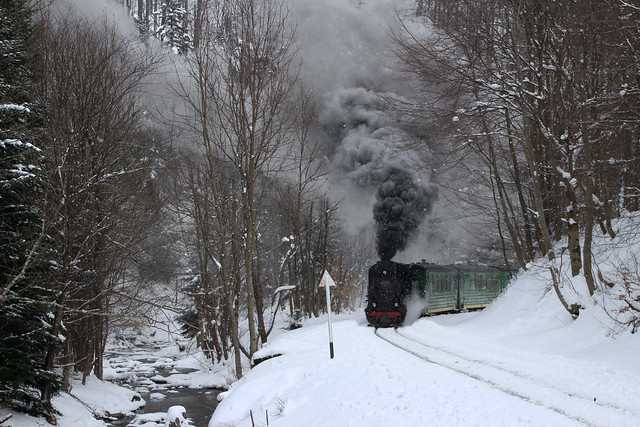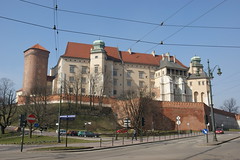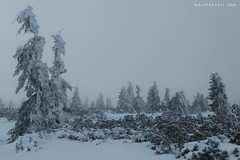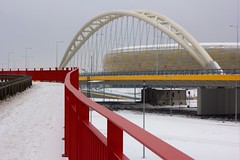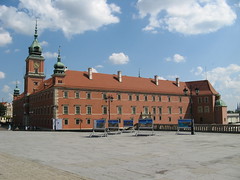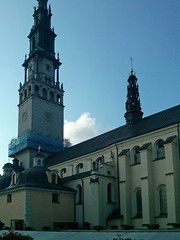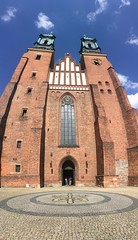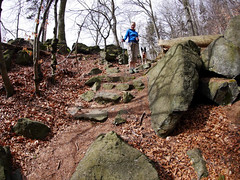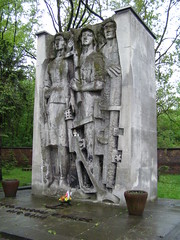 Poland
Poland
Poland,efn|Polish: Polska Polish: /'polska/}} officially the Republic of Poland, is a country in Central Europe. It is divided into 16 administrative provinces called voivodeships, covering an area of . Poland has a population of 38 million and is the fifth-most populous member state of the European Union. Warsaw is the nation's capital and largest metropolis. Other major cities include Kraków, Wrocław, Łódź, Poznań, Gdańsk, and Szczecin.
Poland has a temperate transitional climate and its territory traverses the Central European Plain, extending from Baltic Sea in the north to Sudeten and Carpathian Mountains in the south. The longest Polish river is the Vistula, and Poland's highest point is Mount Rysy, situated in the Tatra mountain range of the Carpathians. The country is bordered by Lithuania and Russia to the northeast, Belarus and Ukraine to the east, Slovakia and the Czech Republic to the south, and Germany to the west. It also shares maritime boundaries with Denmark and Sweden.
The history of human activity on Polish soil dates to circa 10,000 BC. Culturally diverse throughout late antiquity, the region became inhabited by tribal Polans who gave Poland its name in the early medieval period. The establishment of statehood in 966 coincided with a pagan ruler of the Polans converting to Christianity under the auspices of the Roman Church. The Kingdom of Poland emerged in 1025 and in 1569 cemented its longstanding association with Lithuania, thus forming the Polish–Lithuanian Commonwealth. It was one of the great powers of Europe at the time, with a uniquely liberal political system that adopted Europe's first modern constitution in 1791.
With the passing of a prosperous Polish Golden Age, the country was partitioned by neighbouring states at the end of the 18th century and regained its independence in 1918 as the Second Polish Republic. In September 1939, the German-Soviet invasion of Poland marked the beginning of World War II, which resulted in the Holocaust and millions of Polish casualties. As a member of the Communist Bloc in the global Cold War, the Polish People's Republic was a founding signatory of the Warsaw Pact. Through the emergence and contributions of the Solidarity movement, the communist government was dissolved and Poland re-established itself as a democratic state in 1989.
Poland is a parliamentary republic, with its bicameral legislature comprising the Sejm and the Senate. It is a developed market and a high income economy. Considered a middle power, Poland has the sixth largest economy in the European Union by GDP (nominal) and the fifth largest by GDP (PPP). It provides high standards of living, safety and economic freedom, as well as free university education and a universal health care system. The country has 17 UNESCO World Heritage Sites, 15 of which are cultural. Poland is a founding member state of the United Nations, as well as a member of the World Trade Organization, NATO, and the European Union (including the Schengen Area).
Etymology
The native Polish name for Poland is . The name is derived from the Polans, a West Slavic tribe who inhabited the Warta River basin of present-day Greater Poland region (6th–8th century CE). The tribe's name stems from the Proto-Slavic noun pole meaning field, which in-itself originates from the Proto-Indo-European word *pleh₂- indicating flatland. The etymology alludes to the topography of the region and the flat landscape of Greater Poland. The English name Poland was formed in the 1560s, from German and the suffix -land, denoting a people or nation. Prior to its adoption, the Latin form Polonia was widely used throughout medieval Europe.
The country's alternative archaic name is Lechia and its root syllable remains in official use in several languages, notably Hungarian, Lithuanian, and Persian. The exonym possibly derives from either Lech, a legendary ruler of the Lechites, or from the Lendians, a West Slavic tribe that dwelt on the south-easternmost edge of Lesser Poland. The origin of the tribe's name lies in the Old Polish word lęda (plain). Initially, both names Lechia and Polonia were used interchangeably when referring to Poland by chroniclers during the Middle Ages.
History
Prehistory and protohistory
The first Stone Age archaic humans and Homo erectus species settled what was to become Poland approximately 500,000 years ago, though the ensuing hostile climate prevented early humans from founding more permanent encampments. The arrival of Homo sapiens and anatomically modern humans coincided with the climatic discontinuity at the end of the Last Glacial Period (10,000 BC), when Poland became habitable. Neolithic excavations indicated broad-ranging development in that era; the earliest evidence of European cheesemaking (5500 BC) was discovered in Polish Kuyavia, and the Bronocice pot is incised with the earliest known depiction of what may be a wheeled vehicle (3400 BC).
The period spanning the Bronze Age and the Early Iron Age (1300 BC–500 BC) was marked by an increase in population density, establishment of palisaded settlements (gords) and the expansion of Lusatian culture. A significant archaeological find from the protohistory of Poland is a fortified settlement at Biskupin, attributed to the Lusatian culture of the Late Bronze Age (mid-8th century BC).
Throughout antiquity (400 BC–500 AD), many distinct ancient populations inhabited the territory of present-day Poland, notably Celtic, Scythian, Germanic, Sarmatian, Baltic and Slavic tribes. Furthermore, archaeological findings confirmed the presence of Roman Legions sent to protect the amber trade. The Polish tribes emerged following the second wave of the Migration Period around the 6th century AD; they were Slavic and possibly may have included assimilated remnants of peoples that earlier dwelled in the area. Beginning in the early 10th century, the Polans would come to dominate other Lechitic tribes in the region, initially forming a tribal federation and later a centralised monarchial state.
Kingdom of Poland
Poland began to form into a recognisable unitary and territorial entity around the middle of the 10th century under the Piast dynasty. In 966, ruler of the Polans Mieszko I accepted Christianity under the auspices of the Roman Church with the Baptism of Poland. An incipit titled Dagome iudex first defined Poland's geographical boundaries with its capital and bishopric at Gniezno, and affirmed that its monarchy was under the protection of the Apostolic See. The country's early origins were described by Gallus Anonymus in Gesta principum Polonorum, the oldest Polish chronicle. An important national event of the period was the martyrdom of Saint Adalbert, who was killed by Prussian pagans in 997 and whose remains were reputedly bought back for their weight in gold by Mieszko's successor, Bolesław I the Brave.
In 1000, at the Congress of Gniezno, Bolesław obtained the right of investiture from Otto III, Holy Roman Emperor, who assented to the creation of additional bishoprics. Three new dioceses were subsequently established in Kraków, Kołobrzeg, and Wrocław. Also, Otto bestowed upon Bolesław royal regalia and a replica of the Holy Lance, which were later used at his coronation as the first King of Poland in circa 1025, when Bolesław received permission for his coronation from Pope John XIX. Bolesław also expanded the realm considerably by seizing parts of German Lusatia, Czech Moravia, Upper Hungary and southwestern regions of the Kievan Rus'.
The transition from paganism in Poland was not instantaneous and resulted in the pagan reaction of the 1030s. In 1031, Mieszko II Lambert lost the title of king and fled amidst the violence. The unrest led to the transfer of the capital to Kraków in 1038 by Casimir I the Restorer. In 1076, Bolesław II re-instituted the office of king, but was banished in 1079 for murdering his opponent, Bishop Stanislaus. In 1138, the country fragmented into five principalities when Bolesław III Wrymouth divided his lands among his sons. These comprised Lesser Poland, Greater Poland, Silesia, Masovia and Sandomierz, with intermittent hold over Pomerania. In 1226, Konrad I of Masovia invited the Teutonic Knights to aid in combating the Baltic Prussians; a decision that led to centuries of warfare with the Knights.
In the mid-13th century, Henry I the Bearded and Henry II the Pious aimed to unite the fragmented dukedoms, but the Mongol invasions and the death of Henry II in battle hindered the unification. As a result of the devastation which followed, depopulation and the demand for craft labour spurred a migration of German and Flemish settlers into Poland, which was encouraged by the Polish dukes. In 1264, the Statute of Kalisz introduced unprecedented autonomy for the Polish Jews, who came to Poland fleeing persecution elsewhere in Europe. In 1320, Władysław I the Short became the first king of a reunified Poland since Przemysł II in 1296, and the first to be crowned at Wawel Cathedral in Kraków.
Beginning in 1333, the reign of Casimir III the Great was marked by developments in castle infrastructure, army, judiciary and diplomacy. Under his authority, Poland transformed into a major European power; he instituted Polish rule over Ruthenia in 1340 and imposed quarantine that prevented the spread of Black Death. In 1364, Casimir inaugurated the University of Kraków, one of the oldest institutions of higher learning in Europe. Upon his death in 1370, the Piast dynasty came to an end. He was succeeded by his closest male relative, Louis of Anjou, who ruled Poland, Hungary and Croatia in a personal union. Louis' younger daughter Jadwiga became Poland's first female monarch in 1384.
In 1386, Jadwiga of Poland entered a marriage of convenience with Władysław II Jagiełło, the Grand Duke of Lithuania, thus forming the Jagiellonian dynasty and the Polish–Lithuanian union which spanned the late Middle Ages and early Modern Era. The partnership between Poles and Lithuanians…
Looking for places related to Poland?
Those are other destinations to find places related to Poland:
